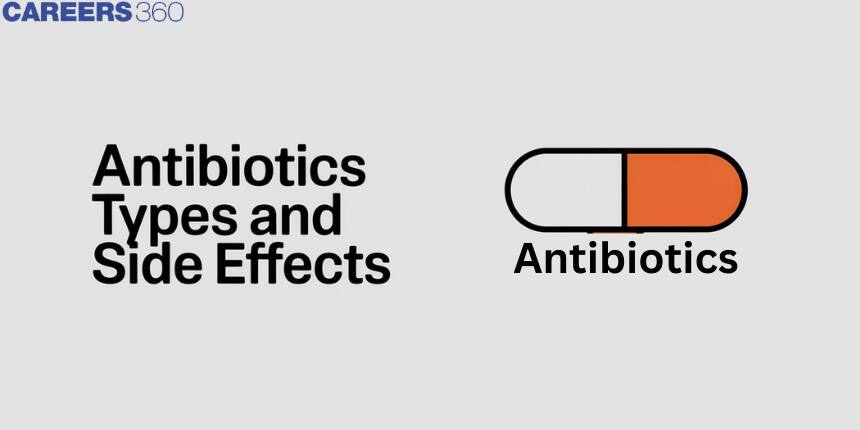Antibiotics Types And Side Effects: History, How it Works, Types
Antibiotics are a powerful group of drugs that fight infections and can even save lives if used correctly. They work by stopping the growth of bacteria or killing them completely. But our immune system kills bacteria before they multiply and cause symptoms. While white blood cells attack harmful bacteria that cause symptoms, our immune system usually fights infection. Unable to fight them, sometimes antibiotics are used.
This Story also Contains
- History Of Antibiotic
- How Do Antibiotics Work?
- Type Of Antibiotic
- Antibiotic Resistance
- Side Effects Of Antibiotics

If you know what penicillin is, you know that it was the first antibiotic discovered and is used to treat certain infections. There are also a number of topical antibiotics available as OTC ointments and creams.
History Of Antibiotic
Initially, antibiotics were derived from microorganisms. Antibiotics were developed synthetically in late years after advances in synthetic methods.
In the 19th century, German bacteriologist Paul Ehrlich began searching for chemicals that could kill bacteria in both humans and animals, but without affecting health. After conducting some research, he discovered a drug called Arsphenamine, also known as Salvarsan. It is used to treat syphilis caused by spirochetes. He won the Nobel Prize in 1908. The drug had some side effects, but its effect on bacteria was far greater than on humans.
In 1932, another drug called Prontosil was discovered by a group of researchers at the Bayer Institute. It was very similar to salvarsan, which tends to convert to sulfanilamide when ingested.
But the real change in antibacterial treatment came in 1929 when Alexander Fleming discovered a natural antibiotic called penicillin.
How Do Antibiotics Work?
There are many different types of antibiotics, but they work in two basic ways.
1. Some antibiotics, like penicillin, tend to dislodge bacteria when they kill them. They usually do this by interfering with the formation of the bacterial cell contents or cell wall.
2. Other types of antibiotics inhibit the growth of bacteria.
Type Of Antibiotic
Antibiotics is usually classified based on their chemical structure. Antibiotics with the same structural class have similar properties in terms of efficacy, sensitizing and toxicity. Some of them are-
Penicillin
macrolide
Sulfonamide
Cephalosporins
Tetracycline system
Fluoroquinolone
Aminoglycoside
Depending on how they work to prevent bacterial infections, they are classified as:
Bactericidal: Tends to destroy pathogenic bacteria in the body. For example, penicillin and polymyxin are among them.
Bacteriostatic: A drug used to inhibit the growth of microorganisms. Examples include chloramphenicol and tetracycline.
Depending on the spectrum of antibiotics, they are divided into two categories:
Wide range:
These are drugs that inhibit or destroy the growth of a wide range of Gram-positive and Gram-negative bacteria. For example amoxicillin
Narrow spectrum:
These types of antibiotics usually attack gram-positive or gram-negative bacteria. For example, penicillin G
Limited spectrum:
These antibiotics are also effective against certain types of organisms and diseases.
Antibiotic Resistance
The emergence of bacterial resistance to antibiotics is a very common phenomenon. The emergence of bacterial resistance reflects the evolutionary processes that occur during antibiotic treatment. Antibiotic therapy may tend to select bacterial strains that are genetically or physiologically enhanced to tolerate higher doses of antibiotic drugs. Under some conditions, the growth of resistant bacteria may be favourable, while the growth of sensitive bacteria is inhibited by antibiotics.
Side Effects Of Antibiotics
Antibiotics are usually tested several times before clinical use. However, there are still some negative effects in using it. Side effects are generally less severe and include common side effects such as nausea, loose stools (faeces), and diarrhea.
Some side effects of antibiotics include:
Anorexia
Increased appetite
nosebleed
gout
Hepatotoxicity
hiccups
hyperkalemia
Arthralgia(joint pain)
Nephrolithiasis(kidney stones)
Decreased libido
Libido, increase
muscle pain (muscle pain)
nasal congestion
Frequently Asked Questions (FAQs)
Depending on the spectrum of antibiotics, they are divided into two categories:
Wide range:
These are drugs that inhibit or destroy the growth of a wide range of Gram-positive and Gram-negative bacteria. For example amoxicillin
Narrow spectrum:
These types of antibiotics usually attack gram-positive or gram-negative bacteria. For example, penicillin G
Limited spectrum:
These antibiotics are also effective against certain types of organisms and diseases.
Some side effects of antibiotics include:
Anorexia
Increased appetite
nosebleed
gout
Hepatotoxicity
hiccups
hyperkalemia
Arthralgia(joint pain)
Nephrolithiasis(kidney stones)
Decreased libido
Libido, increase
muscle pain (muscle pain)
nasal congestion
The emergence of bacterial resistance to antibiotics is a very common phenomenon. The emergence of bacterial resistance reflects the evolutionary processes that occur during antibiotic treatment. Antibiotic therapy may tend to select bacterial strains that are genetically or physiologically enhanced to tolerate higher doses of antibiotic drugs. Under some conditions, the growth of resistant bacteria may be favorable, while the growth of sensitive bacteria is inhibited by antibiotics.
There are many different types of antibiotics, but they work in two basic ways-
1. Some antibiotics, like penicillin, tend to dislodge bacteria when they kill them. They usually do this by interfering with the formation of the bacterial cell contents or cell wall.
2. Other types of antibiotics inhibit the growth of bacteria.
The Types of antibiotics based on the same structural class and similar properties are-
Penicillin
macrolide
Sulfonamide
Cephalosporins
Tetracycline system
Fluoroquinolone
Aminoglycoside